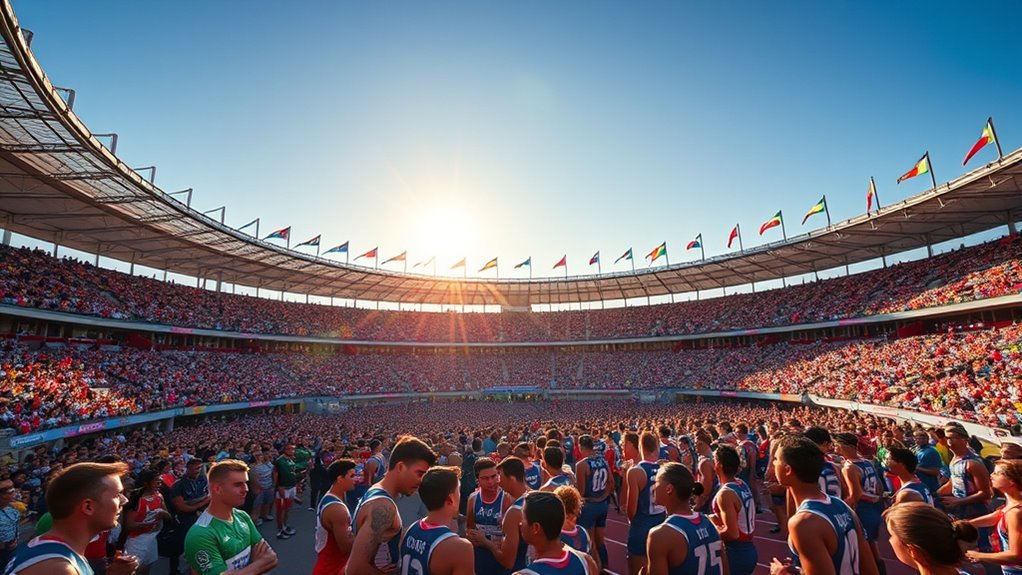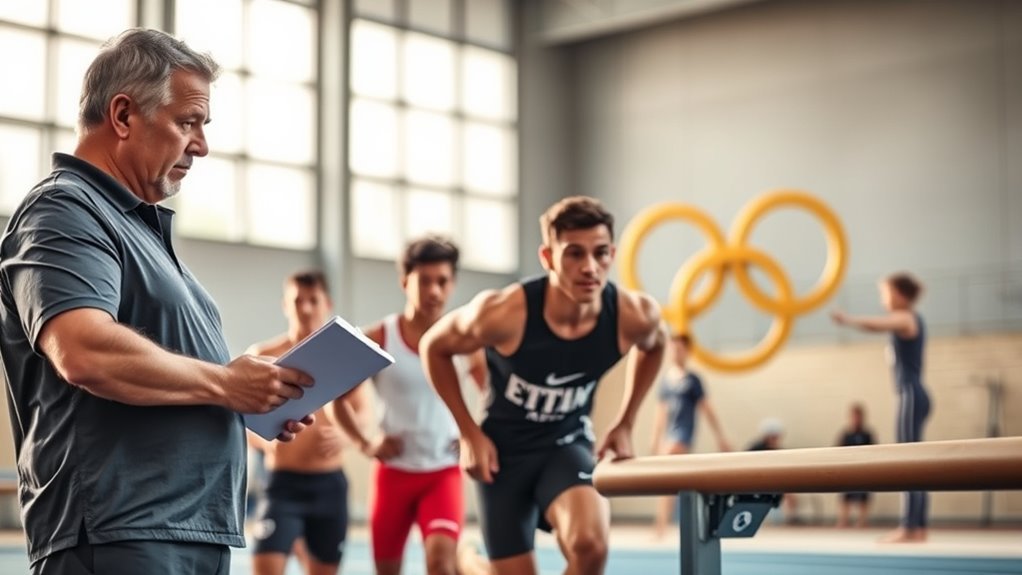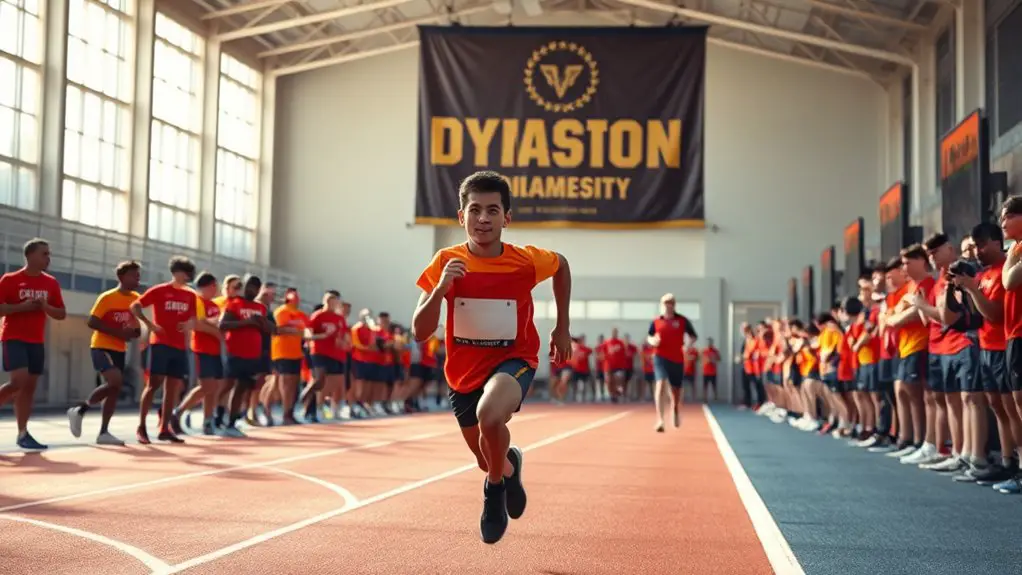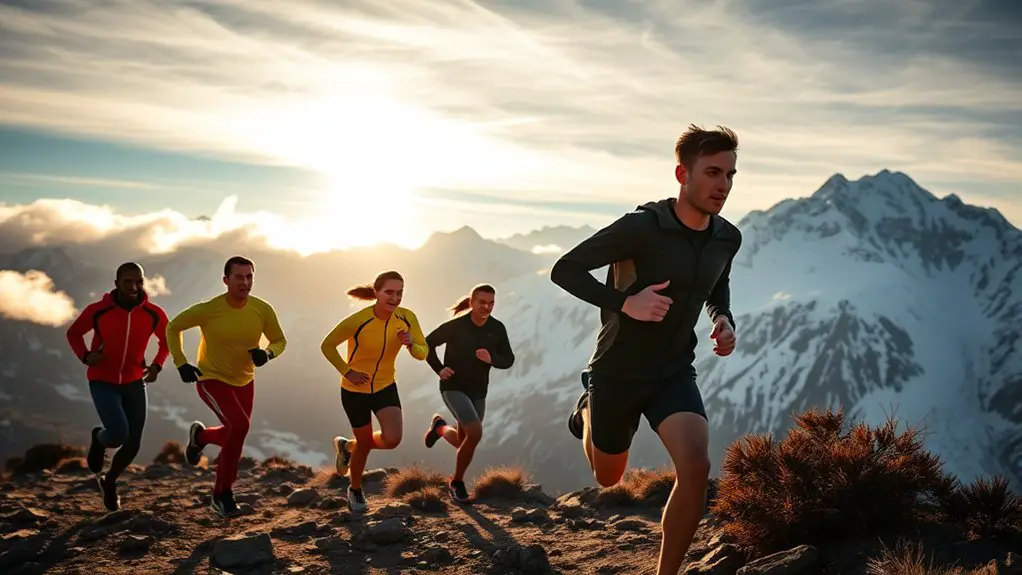The Olympics typically feature around 11,000 athletes from over 200 nations, showcasing a rich diversity of talents and cultures. You’ll see athletes from all walks of life competing in various sports, from athletics to swimming. The number of competitors can vary based on sports and qualification standards set by national governing bodies. There’s more to discover about how athlete participation has evolved and the influential factors at play, so keep exploring!
Overview of Olympic Participation
When you think about the Olympics, it’s hard not to be amazed by the sheer number of athletes who compete. The Olympic demographics showcase a stunning range of participants from all corners of the globe, each representing their unique culture and spirit. This athlete diversity is what makes the Games so powerful and inspiring. You’ve got competitors from various backgrounds, genders, and disciplines, each chasing their dreams in pursuit of freedom and excellence. Watching them brings a sense of unity, reminding you that despite differences, we all share a common passion for sport. The Olympics celebrate this diversity, highlighting the incredible talent and resilience of athletes who come together to compete on the world stage.
Historical Trends in Athlete Numbers
As the Olympics have evolved over the years, the number of athletes competing has seen significant changes, reflecting broader social and political trends. Historical fluctuations in athlete demographics have shaped the Games into a more inclusive event. In the early 20th century, participation was largely dominated by male athletes from a few nations, but as the world’s political landscape changed, so did the representation of diverse nations and genders. You might notice that the total athlete count surged in the latter half of the century as more countries embraced the Olympic spirit. Today, the Games are a reflection of human potential, showcasing athletes from all walks of life, united in the pursuit of freedom and excellence on a global stage.
Factors Influencing Athlete Count
Several factors influence the number of athletes competing in the Olympics, shaping both the event’s scope and its inclusivity. One key aspect is athlete demographics, as different countries bring unique talents and backgrounds, creating a rich tapestry of competition. The willingness of nations to invest in training programs also plays a role, enabling more athletes to pursue their dreams. Participation diversity is another significant factor; when the Olympics embrace various sports and disciplines, more athletes can showcase their skills. Additionally, global events, such as political changes or economic conditions, can impact athlete representation. By addressing these factors, the Olympics can continue to evolve, allowing for a broader range of athletes to participate and celebrate their freedom to compete on the world stage.
Breakdown by Sport and Discipline
While the overall athlete count in the Olympics can vary, the breakdown by sport and discipline reveals the diverse nature of the Games. Different sports attract various athlete demographics, influenced by sport popularity across nations. For instance, team sports often see larger contingents, while niche sports may feature fewer competitors.
| Sport | Athletes | Popularity |
|---|---|---|
| Athletics | 2000 | High |
| Swimming | 1500 | Very High |
| Gymnastics | 800 | High |
This breakdown showcases how athletes from all walks of life come together, pursuing their dreams on a global stage. Embracing the spirit of freedom, the Olympics celebrates not just competition but unity in diversity.
Qualification Standards for Athletes
When it comes to qualifying for the Olympics, you’ll find that each sport has its own specific criteria. National governing bodies play a vital role in setting these standards, ensuring that athletes meet the necessary benchmarks. Understanding these qualifications can help you appreciate the journey athletes take to reach the Games.
Event-Specific Criteria
To qualify for the Olympics, athletes must meet specific criteria that vary by sport, ensuring that only the most skilled competitors are selected. These event criteria are crafted to challenge athletes and maintain a high standard. You’ll find that each sport has its own benchmarks, which can include performance times, scores, or rankings. Meeting these standards is vital for athlete eligibility, as it reflects their ability and dedication. Some sports even have qualifying events where you can showcase your talent. This system not only promotes fairness but also emphasizes the spirit of competition, allowing you to aim for your best. Ultimately, it’s about pushing boundaries and embracing the freedom to represent your country on the world stage.
National Governing Bodies
Athletes aiming for Olympic competition must navigate the standards set by their respective National Governing Bodies (NGBs). These organizations establish qualification criteria that reflect national policies and the spirit of competition. They’re vital in determining who gets the chance to shine on the world stage.
NGBs also play a significant role in athlete funding, ensuring that talented individuals receive the resources they need to train and compete. However, this funding can vary widely, depending on the sport and the country’s priorities. It’s essential for you to understand the specific requirements and support available from your NGB to maximize your potential. By aligning with these standards, you’re not just chasing medals; you’re crafting your path to freedom in sport.
Impact of Global Events on Participation
Global events can greatly impact participation in the Olympics, as seen during times of crisis or upheaval. Global disruptions, like pandemics or political unrest, can severely limit athlete mobility, preventing athletes from training effectively or even traveling to compete. When borders close and travel bans are enforced, the dream of competing on the world stage can slip away for many. This loss of mobility doesn’t just affect individual athletes; it changes the dynamics of entire teams and nations. The essence of the Olympics is about bringing together diverse talents from around the world, and when that’s compromised, the spirit of freedom and unity falters. Therefore, the connection between global events and Olympic participation is vital to understand.
The Role of National Olympic Committees
National Olympic Committees play an essential role in organizing and overseeing their country’s participation in the Olympics. They handle everything from selecting athletes to ensuring national representation in various sports. Understanding their function can give you insight into how your favorite athletes make it to the Games.
Function of National Committees
Every country has its own National Olympic Committee (NOC), which plays an essential role in organizing and supporting athletes for the Olympic Games. These committees are vital in overseeing national committee roles, ensuring athletes have the resources they need to succeed. They manage funding allocations, distributing financial support to various sports and athletes, fostering an environment where talent can thrive. By securing sponsorships and government support, NOCs empower athletes to pursue their dreams without the burden of financial constraints. They also promote the Olympic ideals, encouraging participation in sports at all levels. Ultimately, NOCs are the backbone of a nation’s Olympic presence, helping athletes realize their potential on the world stage while championing freedom and unity through sport.
Athlete Selection Processes
While the journey to the Olympic Games is often grueling, the selection process for athletes is a critical function of the National Olympic Committees (NOCs). You’ll find that these committees establish athlete eligibility standards based on various selection criteria, which can vary by sport. This guarantees that only the most qualified athletes represent their nations. NOCs assess performance metrics, past achievements, and sometimes even conduct trials to gauge talent. As an aspiring Olympian, you must understand these processes, as they can greatly impact your path to the Games. It’s not just about talent; it’s about meeting the specific benchmarks set forth by your NOC, which ultimately shapes your Olympic dreams.
National Representation in Sports
The role of National Olympic Committees (NOCs) goes beyond just selecting athletes; they also guarantee that each nation is represented fairly and effectively in the Olympic Games. By supporting international athletes, NOCs foster a sense of unity and pride among their citizens, showcasing the diverse cultures and talent each country brings to the global stage. You’ll find that these committees assure that the athletes competing are not just the best in their sport, but also reflect the rich tapestry of their nation’s heritage. This cultural representation is crucial, as it allows the world to appreciate the unique stories and backgrounds that each athlete embodies. Ultimately, NOCs empower nations to shine brightly in the spirit of competition and camaraderie.
Future Projections for Olympic Competitors
How might the landscape of Olympic competition evolve in the coming years? As we look ahead, you might notice shifts in athlete demographics and the emergence of new sports. Future competitions could feature a more diverse range of athletes, reflecting global talent and cultural representation.
Here’s a glimpse of potential changes:
| Aspect | Future Trends |
|---|---|
| Athlete Demographics | Increased diversity in age, gender, and nationality |
| New Sports | Inclusion of emerging sports like esports and skateboarding |
These trends may empower more individuals to pursue their athletic dreams, embracing the freedom to compete on the world stage. As the Olympics evolve, your opportunity to witness groundbreaking performances will only grow!
Frequently Asked Questions
How Are Athletes Selected for the Olympics?
Athletes are selected for the Olympics based on Olympic selection criteria set by their sport’s governing bodies. You’ll need to meet athlete eligibility requirements, which include factors like age, nationality, and performance standards. Many nations hold trials or competitions to determine who qualifies. It’s all about showcasing your dedication and talent! If you put in the hard work, you’ll have the chance to represent your country on the world stage.
What Is the Average Age of Olympic Athletes?
The average age of Olympic athletes hovers around 27 years old, a vibrant age where dreams soar high. Olympic trends show a mix of youth and experience, with some sports favoring younger competitors while others embrace seasoned veterans. You’ll find athletes in their teens and even those in their 40s, reflecting the freedom of sport. It’s this blend of ages that makes the Games a fascinating spectacle of talent and passion.
Are There Any Sports With Gender-Specific Athlete Limits?
Yes, there are sports with gender-specific athlete limits, often due to event quotas aimed at promoting gender equality. These quotas can restrict the number of male or female competitors in certain events. While this approach can help balance representation, it sometimes creates frustration among athletes who feel their opportunities are limited. You’ll find that discussions around these limits often center on achieving fairness and ensuring every athlete has the chance to compete.
How Many Countries Participate in the Olympics?
Around 206 countries typically participate in the Olympics, showcasing global sports representation. You’ll find nations from every corner of the world, each bringing unique talents and cultures to the games. Olympic participation statistics reveal the spirit of unity and competition among diverse athletes. It’s a celebration of freedom, where nations come together, transcending boundaries and differences. So, whether you’re cheering for your country or another, it’s about the shared love for sports.
What Happens if an Athlete Fails a Drug Test?
If an athlete fails a drug test, they face serious consequences, including disqualification and potential bans from future competitions. Curiously, around 1% of athletes are found to have used banned substances during the Olympics, highlighting the importance of drug testing. These consequences not only affect their careers but can also tarnish their reputations. Athletes aim for freedom in their sport, but those choices can lead to significant repercussions.




